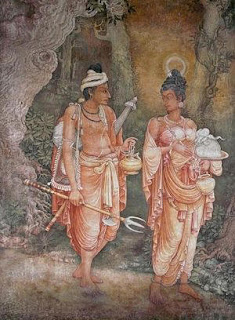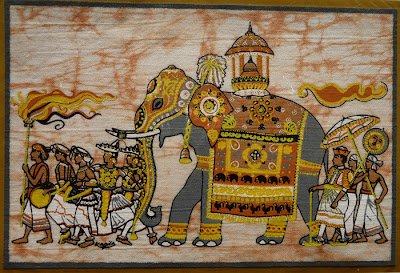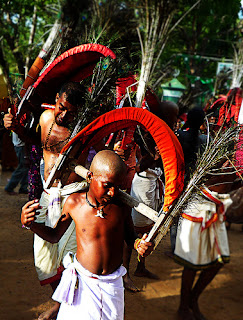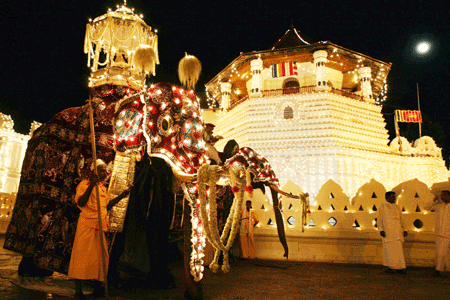
|
|||||||||
|
| |||||||||
In Honor of the Sacred Tooth Relic: The Esala PeraheraVisually, the Esala Perahera festival is about drummers, fire dancers and magnificent elephants adorned in the finest of costumes, parading through the streets at night. But as one can expect, there is purpose and reason behind the festival. In fact, the Esala Perahera is deeply rooted in the Buddhist traditions of Sri Lanka.
According to tradition, after Buddha died, his body was cremated in a sandalwood pyre and his left canine tooth was retrieved from the funeral pyre by the Ascetic Arahat Khema and given to King Brahmadatta of Dantapura in Kalinga (the present Orissa in India) in the 3rd century BC. A belief grew that whoever possessed the Sacred Tooth Relic had a divine right to rule the land. Wars were fought to take possession of the Tooth Relic.
How the Tooth Relic Ended up in Sri Lanka After an adventurous journey, they reached Anuradhapura where they gave the Tooth Relic to the king. Tradition too has it that the Princess brought the Tooth Relic to Sri Lanka hidden in the coils of her hair. Ever since it was brought to Sri Lanka, the Tooth Relic has been venerated in the form of ritual ceremonies. As the ancient kingdoms of Sri Lanka moved from one capital to another, the Tooth Relic was also moved to various temples but the pageant has continued through to present day becoming ever more colorful and ornate over time.
Continuing the age old traditions, the Tooth Relic is revered by way of various ritualistic ceremonies throughout the year. Among the many festivals, the most extravagant of them all is undoubtedly the Esala Perahera which takes place July/August of every year. The Esala Perahera festival is actually a synthesis of Hindu and Buddhist beliefs; a fusion of two separate "peraheras" (processions) - the Esala and Dalada. The Esala Perahera is thought to date back to the 3rd century BC and was the ritual enacted to invoke the blessings of the gods for rain, fertility, successful crops and good health. The Dalada Perahera is believed to be the ceremony introduced in the 4th century BC during the reign of King Kirthi Sri Meghavarna. The modern Perahera dates back to the reign of the Kandyan King Kirthi Sri Rajasinghe (1747–1781). In those days, the Tooth Relic was considered private property of the King and the public never got a chance to worship it. However, King Rajasinghe decreed that the Tooth Relic be taken in procession for the masses to see and venerate.
After the Kandyan Kingdom fell to the British in 1815, the custody of the Relic was handed over to the Buddhist clergy. In the absence of the king, a lay custodian called the "Diyawadana Nilame" was appointed to handle routine administrative matters. The Esala Perahera festival is held each year in the hillside city of Kandy. It is a fifteen day festival exhibiting traditional music, dancing and drumming, not to mention the procession of the all important Tooth Relic. Elephants have always featured heavily in the Esala Perahera as they are symbols of abundance and fertility. They are the 'clouds who walk the Earth', instrumental in attracting the vital rains for harvest time. Funny to think of the largest land mammal being light as a cloud!
The Festival Schedule
The exact timing of the Esala Perahera varies from year to year. I eagerly kept an eye on the Sri Dalada Maligawa website for the dates to be issued so I could my trip around the last few nights of the festival which are suppose to be the most spectacular. This year (2012), the Esala Perahera begins on July 19th with the Kap Situveema or Kapa, in which a sanctified young jackfruit tree (Artocarpus integrifolia) is cut and planted on the premises of each of the four Devales (shrines) dedicated to the four guardian gods - Natha, Vishnu, Kataragama and the goddess Pattini. For the next four nights, the "Internal Perahera of Four Devales" take place within the premises of the four Devales. The Kubal Perahera takes place from July 23-27th. This is the start the processions through town. At the start of the Kubal Perahera, the Devale Peraheras assemble in front of the Sri Dalada Maligawa. Their insignias are placed on the ransivige (a dome-like structure) accompanied by the Basnayake Nilames (the lay custodians of the Devales). The Tusker Leads the Way The silver relic casket, which is a substitute for the Tooth Relic, is placed inside the ransivige which is then carried by the Maligawa Elephant, a magnificent tusker.
At about 8pm, the Maligawa Perahera joins the awaiting Devale Peraheras and the tusker leads the procession. No one rides on the lead tusker as a mark of respect for the Relic. The elephant that bears the casket of the Tooth Relic is carefully selected based on various criteria. Two more elephants accompany it on either side and the three magnificent elephants create a breathtaking scene. The men who ride the two elephants on either side shower flowers at the casket. The families of these men have been traditionally carrying out these functions and no one else can perform them. The Kavikara Maduwa follows the three elephants, and they are the traditional singers of the perahera and they sing in praise of the Tooth Relic of Lord Buddha. This group also consists of members of families who have been doing this for generations. Whip-crackers and fireball acrobats clear the path, followed by the Buddhist flag bearers.
A group of singers dressed in white heralds the arrival of the Maligawa Tusker carrying the Sacred Tooth Relic. The Diyawadana Nilame (traditionally required to do everything in his power to ensure rain in the correct season) walks in traditional Kandyan-clothed splendor after the tusker.
Dressed in all its elephantine finery of elaborately decorated dress and lights comes the second elephant. Gajanayaka Nilame or the man who heads the King's Elephants comes on this gaily-decorated elephant. Followed by this, dozens of elephants, all dressed in beautiful attire parade the streets among many troupes that perform various dances showcasing the rich culture of Sri Lanka.
Procession of the Devales
Next, the four Devales parade in succession, starting with the Natha Devale. Next comes the Vishnu Devale which is dedicated to the Hindu god, Vishnu. Then comes the Kataragama Devale which is dedicated to the God of Kataragama who is identified with the warrior god Skanda. This procession includes Kavadi, the peacock dance, in which the pilgrim-dances carry semicircular wooden contraptions studded with peacock feathers on their shoulders.
The fifth and final procession is from the Pattini Devale which is dedicated to the goddess Pattini who is associated with the cure of infectious diseases and is called upon in times of drought and famine. This is the only procession that has women dancers.
It is believed that the pageants of the four Devales were added to the main perahera during the reign of the Nayakkar kings who had their origins in the Hindu tradition.
Dressed in his traditional Kandyan costume and elaborate jewelry, the Diyawadana Nilame (lay custodian of the Tooth Relic) proudly marches along the streets. A man holds an umbrella above his head and eight others bearing traditional arms walk beside him. The Diyawadana Nilame is followed by the Basnayaka Nilames, the lay custodians of the four Devales. The more elaborate Randoli Perahera begins after five nights of the Kumbal Perahera. Randoli refers to palanquins on which the Queens of the ruling Kings traditionally traveled. For the Randoli Perahera, the relic casket is not made of silver but of gold. The last two nights of the Randoli Perahera are the grandest so those will be the two nights that I will plan to go to.
Diya Kepeema and the Day Perahera follow the five nights of the Randoli Perahera. The festival ends with the Diya Kepeema, which is the water cutting ceremony at the Mahaweli River at Getambe, a town a few miles from Kandy. A Day Perahera is held to mark the ceremony. Courtesy: LankaPera
|








